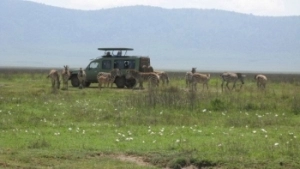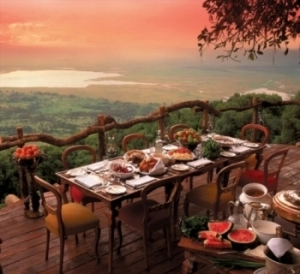Ngorongoro Crater is one of the world's greatest natural spectacles, its magical setting and abundant wildlife never failing to enthrall visitors. Ngorongoro is set in northern Tanzania.
 The Ngorongoro Crater, at 2,286 m above sea level, is the largest unbroken caldera in the world.
The Ngorongoro Crater, at 2,286 m above sea level, is the largest unbroken caldera in the world.Surrounded by very steep walls rising 610 metres from the crater floor, this natural amphitheatre measures 19.2 km in diameter and 304 sq km in area. It is home to up to 30,000 animals, almost half being wildebeest and zebra. Buffalo, elephant, hippo, hyena, jackal, lion, ostrich, serval, warthog, bushbuck, eland, hartebeest, reedbuck, waterbuck and huge herds of both Thomson’s and Grant’s gazelle are easily seen on the crater floor.
Thanks to anti-poaching patrols, the crater is now one of the few places in East Africa where visitors can be certain of seeing black rhino. Leopard may occasionally be seen in the trees of the forest surrounding the crater while cheetah are also present but rarely seen.
Large herds of giraffe live on the rim of the crater and will be seen on the drive to Olduvai Gorge and the Serengeti. Countless flamingo form a pink blanket over the soda lakes while more than 100 species of birds not found in the Serengeti have been spotted.
The crater, which has been declared a UNESCO World Heritage site, lies within the Ngorongoro Conservation Area, which covers more than 8,300 sq km. It is bounded by Lake Eysai in the southwest and the Gol Mountains in the north. Roughly in the centre is the Olbalal Swamp and the arid Olduvai Gorge.
The Ngorongoro Conservation Area boasts the finest blend of landscapes, wildlife, people and archaeological sites in Africa. Often called ‘Africa's Eden’ and the ‘eighth wonder of the natural world’, it is also a pioneering experiment in multiple land use. For Ngorongoro Conservation Area, the idea of multiple land use means to allow humans and wildlife to coexist in a natural setting. Traditional African pastoralists co-operate with Tanzania’s government bodies to help preserve the natural resources of the area and to ensure a fantastic experience for tourists.
Ngorongoro Conservation Area includes its eponymous famous crater, Olduvai Gorge, and huge expanses of highland plains, scrub bush, and forests that cover approximately 8300 square kilometers. A protected area, only indigenous tribes such as the Maasai are allowed to live within its borders. Lake Ndutu and Masek, both alkaline soda lakes are home to rich game populations, as well as a series of peaks and volcanoes and make the Conservation Area a unique and beautiful landscape. Of course, the crater itself, actually a type of collapsed volcano called a caldera, is the main attraction (which is about 250 sq km in size and 600 m deep). The crater alone has over 20,000 large animals including some of Tanzania’s last remaining black rhino. The rhino emerge from the forests in the mists of early morning, and their prehistoric figures make a striking impression, surrounded by the ancient crater walls. No fences or boundaries border the crater walls; animals are free to enter or leave the crater, but many of them stay for the plentiful water and grazing available on the crater floor throughout the year.
Open grassland covers most of the crater floor, turning yellow with wild flowers in June. The Makat soda lake is a great attraction for flamingos and other water birds, while predators hide in the marsh to ambush animals that come to drink from the river that feeds the lake. Also on the crater floor are swamps, providing water and habitat for elephant and hippo as well as numerous smaller creatures such as frogs, snakes and serval cats. Game viewing around Lake Makat is especially rewarding – large antelope like zebra and gazelle come to drink, while herds of hippos sun themselves in the thick lakeshore mud.
The Lerai Forest on the crater floor gets its name from the Maasai word for the elegant yellow-barked acacia tree. Elephants often graze in the forest shade during midday, emerging into the open plains during the early hours of morning and in the evening, as the midday heat abates. The small forest patches on the crater floor are home to leopard, monkey, baboon and antelope such as waterbuck and bushbuck.
The most numerous and recent inhabitants of the Ngorongoro Area are the Maasai, who arrived about 200 years ago. Their strong insistence on traditional custom and costume interests many visitors. As of today, there are approximately 42,000 Maasai pastoralists living in Ngorongoro with their cattle, goats and sheep. Their presence is the main difference between the Ngorongoro Conservation Area and Tanzania’s national parks, which do not allow human habitation. Cultural ‘bomas’, or Maasai villages, give visitors the chance to meet Maasai people on their own terms and learn more about this complex and interesting culture.
 Accommodation is located on its ridges and after a beautiful descent down the crater rim, passing lush rain forest and thick vegetation, the flora opens to grassy plains throughout the crater floor. The game viewing is truly incredible, and the topography and views of the surrounding Crater Highlands out of this world.
Accommodation is located on its ridges and after a beautiful descent down the crater rim, passing lush rain forest and thick vegetation, the flora opens to grassy plains throughout the crater floor. The game viewing is truly incredible, and the topography and views of the surrounding Crater Highlands out of this world.Getting to Ngorongoro Crater:
A three hour drive, or one hour flight, from Arusha. A two hour drive from Tarangire or some 90 minutes from Manyara.
When to visit Ngorongoro Crater:
You may visit this area any time of the year, each season has its own special highlights! Some of the walking safaris are designed to fit in with the wildebeest migration in the Ndutu region, or to take advantage of the drier and cooler months, but a vehicle safari is accessible all year round.
OLDUVAI GORGE
Located within the Ngorongoro Conservation Area, a short drive off the main road between Ngorongoro and the Serengeti, the name Olduvai derives from Oldupai, which is the Masai word for the type of wild sisal that grows in the gorge.
It was here that, in 1959, Dr Louis Leakey and his wife Mary discovered the skull of first Zinjanthropus Boisei, or “nutcracker man”, and then, a year later, the remains of Homo Hablis or “handy man” at that time regarded as mankind’s first step on the ladder of human evolution. Many more fossils have since been discovered including those of prehistoric elephants, giant horned sheep and enormous ostriches. There is a small museum and an observation platform, overlooking the gorge, where visitors can listen to an informative talk.
It takes about 4 hours to drive from Arusha to Olduvai Gorge.
Book your This email address is being protected from spambots. You need JavaScript enabled to view it. now - customized or scheduled safaris available.
Ngorongoro Suggested Safari Itineraries
Ngorongoro Safari Specials
